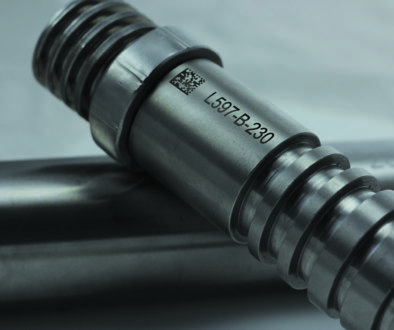Traceability in Manufacturing: 10 Part Marking Machine Considerations

Every part tells a story.
In manufacturing, that story is written with precision and permanence. From serial numbers to intricate barcodes, part markings ensure every component can be identified, traced, and trusted throughout its lifecycle. But how do you choose the right system to deliver these critical marks?
Selecting a part marking machine isn’t just about tools — it’s about seamlessly aligning technology with the unique demands of your production process. Previously, we emphasized how material specification is the first step in selecting a suitable part marking system. Let’s explore the key factors to consider, ensuring your markings meet industry standards and elevate your traceability game.
Here are 10 essential factors to consider when choosing the best direct part marking method for your project, covering everything from content type to budget limits:
Important Industrial Marking Machines Considerations: Who, What, Where, and How Much?
Every manufacturing environment presents unique requirements and challenges for industrial part marking. There’s no one-size-fits-all solution, so manufacturers should consider specific factors to select the most effective part marking methods. Here are 10 important considerations:
- Content of marking
- Mark location
- Size of parts
- Size of marking
- Part geometry
- Product mix
- Production volume
- Operating environment
- Product form and function
- Budget
Enhance Manufacturing with Industrial Laser Marking: Precision & Traceability
Discover how industrial laser marking can elevate your manufacturing process with precision, durability, and efficiency. This comprehensive guide explains how laser marking technology enhances traceability and quality control across various applications.
1. Content of Marking:
The type of content you plan to mark on each part is critical. Common types include:
- Text characters
- Logos
- Barcodes (1D and 2D)
Many part-marking machines handle basic text by default, but complex elements, such as intricate logos or 2D barcodes, may require specific software upgrades. Additionally, consider the size and density of the marking. Ask yourself:
- How many characters are needed?
- How many lines of text are necessary?
- How much space is needed on the part to fit all the markings, such as text, logos, and barcodes?
Not all industrial marking systems can accommodate large or dense markings, so choose a machine that can accommodate your specific requirements.
| Traceability Focus: Consider the data most crucial for traceability. Serial numbers or unique identifiers are essential for tracking individual parts. Barcodes can encode detailed information about a part’s origin, manufacturing process, and inspection details. |
2. Mark Location:
Where the mark will be placed on the part significantly affects the marking method and machine choice. Some parts have accessible, flat surfaces that make laser marking or dot peen marking feasible. Other parts, however, may have restricted or hard-to-reach areas. In such cases, a non-contact marking method, like laser marking, may be preferable over contact methods that require direct surface contact. Make sure the marking equipment can access the desired mark location effectively.
| Traceability Focus: The marking location should not compromise the part’s functionality or structural integrity. For critical components, prioritize marking on non-functional surfaces. |
3. Size of Part:
The size of the component influences the approach to part marking. Smaller parts can be easily transported to a fixed marking station. However, larger or heavier components may require a more portable solution, where the part marking machine can be moved to the part itself. This is especially common for parts that are immobile or stored in a fixed location, like a storage rack or pallet.
| Traceability Focus: Ensure the marking method and machine chosen can effectively mark all parts you intend to track. Consider future production plans and potential changes in part size. |
4. Size of Marking:
The size of the part often dictates the dimensions of the marking itself. For large parts, visible markings can typically be added without difficulty. However, laser marking may be ideal for very small parts with limited surface area due to its ability to create micro-marks visible only under magnification. If precision is paramount, laser marking provides superior control over dot peen or other mechanical marking techniques.
| Traceability Focus: The marking size should be sufficient for clear identification and data capture during scanning for traceability purposes. |
5. Part Geometry:
Marking on different geometries — flat, curved, or irregular — demands varied capabilities from the part marking system. Standard marking machines can mark on flat surfaces, but for cylindrical or complex surfaces, you may need a rotary axis for 360° marking. More intricate geometries might require three-axis control (X, Y, and Z) to create quality marks that accurately follow the part’s contour.
| Traceability Focus: Choose a marking method that can produce clear and consistent markings regardless of the part’s geometry to ensure successful data capture for traceability. |
6. Product Mix:
Will the part marking machine be dedicated to a single product or used across a range of products? In high-mix, low-volume production environments, flexibility is key. A versatile marking system reduces setup time between production runs by accommodating multiple part types without extensive reconfiguration. On the other hand, a dedicated system is more efficient for single-product applications with consistent marking needs.
| Traceability Focus: Ensure the marking system can accommodate different part types and their specific traceability requirements. |
7. Production Volume:
For effective traceability in manufacturing, the volume of parts to be marked impacts both the duty cycle and the type of marking machine required. Low-duty applications (fewer than 100 parts per day) can typically utilize entry-level machines, while higher volumes, especially in the hundreds or thousands per day, demand more durable, industrial-grade equipment.
High-speed marking machines are critical for large production volumes, minimizing downtime and meeting demand. Systems suited for moderate to high volumes may operate at slightly lower speeds but offer enhanced durability.
Automation needs also increase with production rates:
- Low-volume setups are often managed manually.
- Moderate volumes benefit from semi-automated options, like pneumatic shuttles.
- High-volume settings require fully automated systems to achieve peak efficiency.
Selecting the appropriate automation level and machine type ensures consistent, durable marking across any production scale, supporting traceability and operational efficiency.
| Traceability Focus: Choose a marking system that can keep up with your production pace without compromising marking quality or traceability. |
8. Product Form and Function:
Part marking should not alter the functionality or integrity of the component. Laser marking is often preferred for controlled surfaces that can’t tolerate material displacement, as it creates high-precision marks without adding stress to the part. In contrast, dot peen marking can be effective for parts exposed to high-stress environments, such as pipes or valves, as it avoids the thermal shock associated with other marking methods.
| Traceability Focus: The marking system should function reliably in your specific environment to maintain consistent traceability. |
9. Operating Environment:
The operating environment can greatly influence the durability and type of part marking system. For example, environments with high dust or oil contamination might require marking machines designed for rugged conditions and frequent maintenance. Temperature fluctuations or outdoor usage may also impact the machine’s performance, so consider whether the machine is suited for controlled environments or harsher conditions.
| Traceability Focus: The marking should be durable and withstand the part’s intended use without compromising its performance or traceability. |
10. Budget:
Budget constraints influence which marking technology a manufacturer can invest in, but prioritizing only the initial cost can lead to hidden expenses later. Choosing a lower-cost marking machine may seem economical at first. However, this can result in higher long-term costs due to maintenance, production delays, and potential downtime if the machine isn’t suited for high-demand operations.
To avoid these issues, manufacturers should consider OEMs that offer financing options. Financing allows companies to invest in the best-suited marking equipment while spreading costs over time, leveraging operational budgets rather than large capital expenditures. This approach ensures manufacturers select durable, high-performance machines that meet production needs without sacrificing efficiency or traceability.
| Traceability Focus: Prioritize the features and capabilities that contribute directly to your traceability goals. Don’t overspend on unnecessary features. |
Advantages of Laser and Dot Peen Marking
| Marking Technology | Advantages |
|---|---|
| Laser Marking | Laser marking offers unmatched precision and versatility, making it ideal for industries where high-resolution marks are essential. The non-contact nature of laser marking allows it to produce marks without damaging the part surface, ensuring component integrity while providing excellent traceability. |
| Dot Peen Marking | Dot peen marking is highly durable, providing a deep, permanent mark that withstands wear, heat, and abrasion. This method is popular in heavy industries like automotive and aerospace, where parts must endure harsh conditions without losing their identifying marks. |
Choosing the Right Part Marking Solution with Technomark
At Technomark North America, we understand the critical role of traceability in manufacturing. Our laser marking and dot peen marking machines are designed to deliver reliable, high-quality markings across various industries, ensuring each component is traceable throughout its lifecycle. We offer consultation services to help you assess which part marking system best suits your production needs, from high-volume automated laser systems to versatile portable dot peen solutions.
Contact us today for expert guidance on integrating Technomark’s advanced part marking solutions into your production process. Our team is ready to help you achieve unmatched traceability with robust, efficient part-marking machines tailored to your application.
(Editor’s note: This blog was originally published in June 2021 and was updated in November 2024 to reflect the most current information.)





